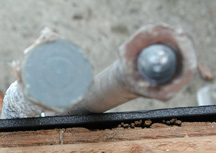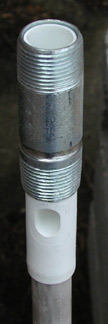Anodes

Anodes |
 |
 |
|
| A new anode, top, as compared to one that had been in use for seven years. Note the bare core wire. | |
| kk | |
The hidden ingredientThe single most important factor in whether a water heater lives or dies is the condition of its sacrificial anode. For more than 50 years, it has been used as a key part of the rust protection of a tank, although few people know it's there. This is a rod made of magnesium or aluminum, that's formed around a steel core wire, and is screwed into the top of the tank. A six-year-warranty residential tank will have one, while a 12-year-warranty tank will have two. Commercial tanks have from one to five. When the tank is filled with water, an electrolytic process begins whereby the anode is consumed to protect a small amount of exposed steel. Electrolysis simply means that when two metals are physically connected in water, one will corrode away to protect the other. Although few people have heard of this, the principle is used all over the place -- anywhere that someone wants to protect metal exposed to water. In marine applications, anodes are known as "zincs." All metals fall somewhere on the galvanic scale of reactivity. When two are place together in water, the "nobler" -- or less reactive -- one will remain intact while the more reactive one corrodes. When steel and copper are together, steel will be the one that corrodes. Indeed, steel is more likely to rust in the presence of copper than it would have been by itself. That's why dielectric unions are necessary on items like copper flex lines when they're connected to steel nipples. Magnesium and aluminum are less noble than steel, which is why they're used for anode rods. Remember, the anode is screwed into the tank. That means it can be unscrewed and replaced. An anode's life depends on the quality of water, the amount of use the tank gets and the quality of the tank. When salt is added to the water (as in softened water), anodes corrode more quickly. Water softeners can help reduce sediment, but anodes can corrode in as little as six months if the water is over-softened. People occasionally ask us if pipe-seal tape applied to the threads of the anode blocks the electrolytical reaction. Tanks we've serviced repeatedly usually have corroded anodes. We've tested with a multimeter and found current flowing between the anode and the tank, despite the tape. |
| If you contemplate adding an anode to a new tank, make sure both rods are of the same metal. Otherwise, the magnesium rod will be consumed more rapidly in the presence of an aluminum one and you won't get as long a life. How do you tell them apart? An aluminum hex head will be flat on top, while a magnesium rod will have a bump, as in the photo at right. |  |
|
The exception to that is Rheem and its sub-brands, Ruud/Richmond/General Electric. As far as we know, Rheem always uses magnesium even though there is no bump on top of its anodes. On the other hand, if the tank is five years old or more, having dissimilar metals is less of an issue, since the original one will likely be largely consumed. And there is no way to tell metal type if a tank has a combo rod, but you're probably going to be replacing it anyway. If you decide to remove and check your anode, we'll tell you some of the possibilities and what they mean. If there is rough, seemingly chewed-up metal all up and down the rod, that's normal. It's doing what it's supposed to do. If you can see six inches of the steel core wire, replace the rod. If all you have IS the steel core wire -- or less -- then extending the life of the tank by replacing the anode becomes more iffy. You might still get several more years out of the next anode. Or the tank might fail shortly after. It all depends on factors that exist where none of us can see them. If the rod looks perfectly intact, with no sign of corrosion, then it has passivated. That means it has sort of gone to sleep. It might not be doing its job. It's a wild-card situation. We've seen tanks with passivated rods last a long time. We've seen them break. We're never sure what will happen next, and apparently none of the experts in this field whom you think might know are any more certain than we are. About all you can do is replace the rod and hope for the best. Or leave it and hope for the best. Wild-card situation. |
Combination and hex-head anodesThere are two configurations of anodes. The first kind is called a hex-head anode and you can see a couple in the photo at the top of the page. They are found in their own port on top of the tank. With most brands, the hex head is exposed. The other kind is called a combination or combo or outlet anode, like the one in the picture at right. It is an anode/hot-water outlet/plastic-lined steel nipple and is used in the hot-water port. Often longer-warranty tanks have one hex-head and one combo rod, although a couple of manufacturers make tanks that have just one combo rod, with no place for a second one. The test is to disconnect the hot plumbing and run a long screwdriver into the nipple. It should be blocked an inch or two down if there is an anode there. |
 |
| Anode rods of all types can be purchased on our product page. |
On to Sediment |
 |
Back to The inside story |
 |
Or Index |
 |